Organizational Behavior: Analysis of Culture, Power, and Politics
VerifiedAdded on 2023/01/19
|17
|5736
|28
AI Summary
This report analyzes the culture, power, and politics within an organization, with a focus on Ryanair. It also explores motivation theories and techniques for teams and individuals.
Contribute Materials
Your contribution can guide someone’s learning journey. Share your
documents today.
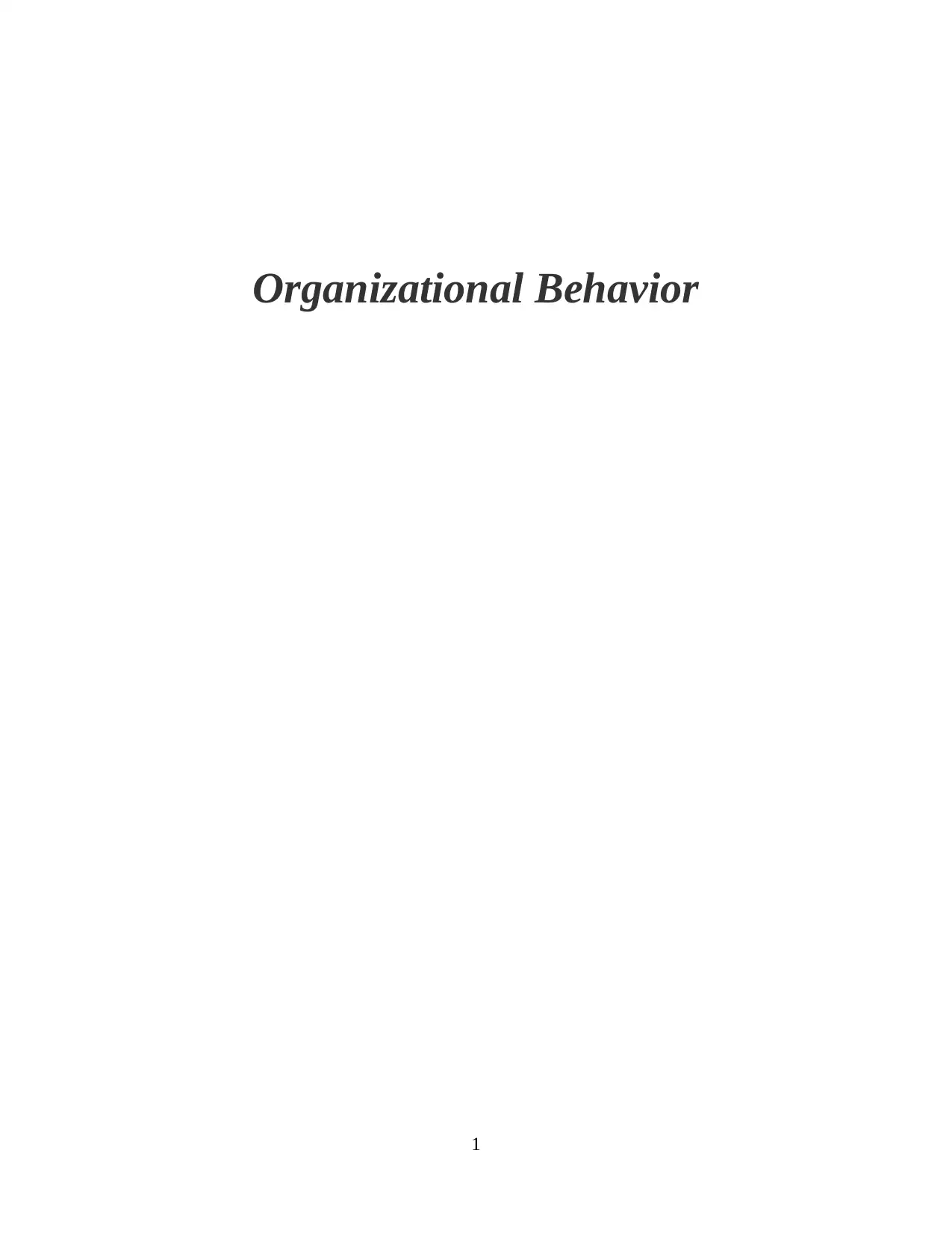
Organizational Behavior
1
1
Secure Best Marks with AI Grader
Need help grading? Try our AI Grader for instant feedback on your assignments.
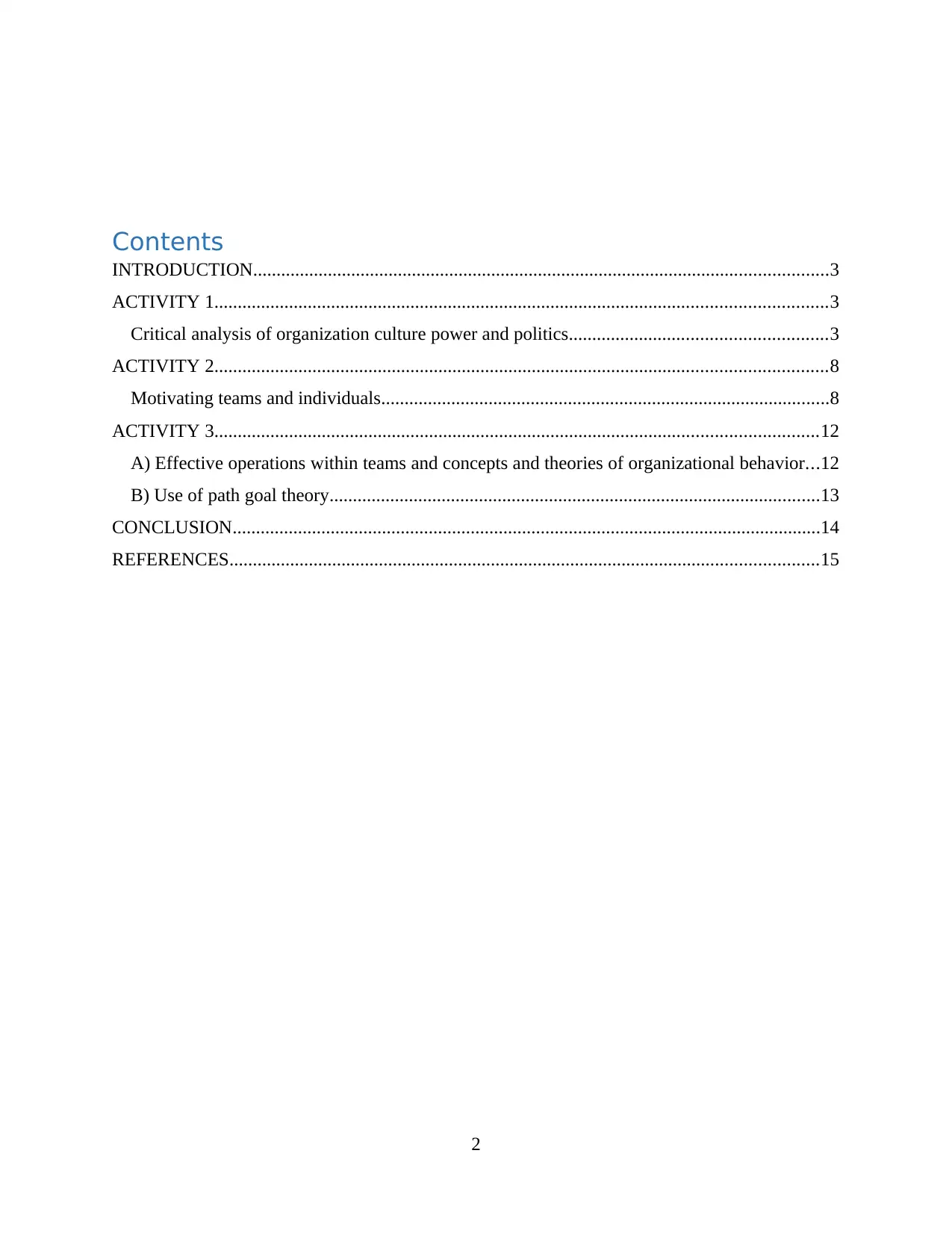
Contents
INTRODUCTION...........................................................................................................................3
ACTIVITY 1...................................................................................................................................3
Critical analysis of organization culture power and politics.......................................................3
ACTIVITY 2...................................................................................................................................8
Motivating teams and individuals................................................................................................8
ACTIVITY 3.................................................................................................................................12
A) Effective operations within teams and concepts and theories of organizational behavior...12
B) Use of path goal theory.........................................................................................................13
CONCLUSION..............................................................................................................................14
REFERENCES..............................................................................................................................15
2
INTRODUCTION...........................................................................................................................3
ACTIVITY 1...................................................................................................................................3
Critical analysis of organization culture power and politics.......................................................3
ACTIVITY 2...................................................................................................................................8
Motivating teams and individuals................................................................................................8
ACTIVITY 3.................................................................................................................................12
A) Effective operations within teams and concepts and theories of organizational behavior...12
B) Use of path goal theory.........................................................................................................13
CONCLUSION..............................................................................................................................14
REFERENCES..............................................................................................................................15
2
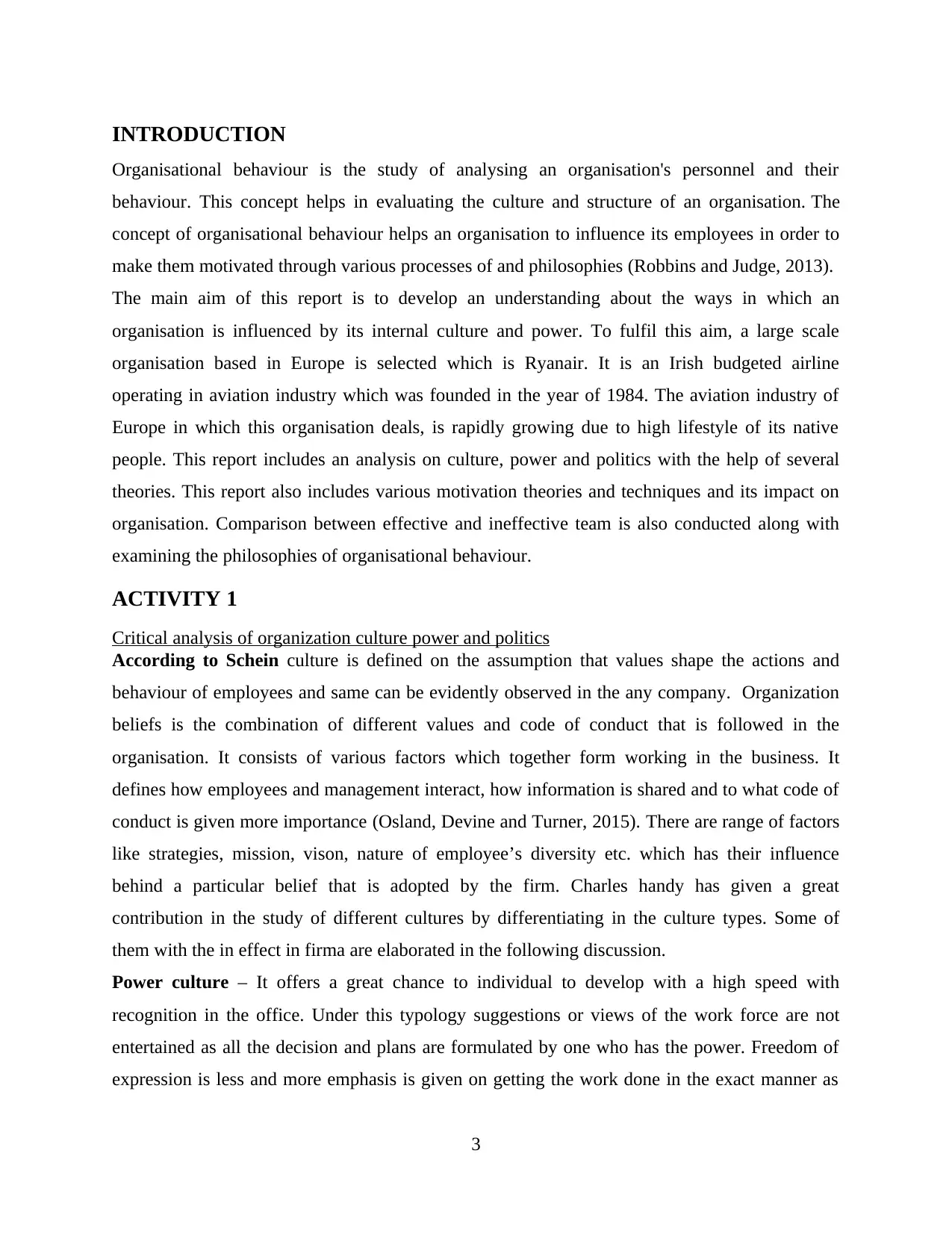
INTRODUCTION
Organisational behaviour is the study of analysing an organisation's personnel and their
behaviour. This concept helps in evaluating the culture and structure of an organisation. The
concept of organisational behaviour helps an organisation to influence its employees in order to
make them motivated through various processes of and philosophies (Robbins and Judge, 2013).
The main aim of this report is to develop an understanding about the ways in which an
organisation is influenced by its internal culture and power. To fulfil this aim, a large scale
organisation based in Europe is selected which is Ryanair. It is an Irish budgeted airline
operating in aviation industry which was founded in the year of 1984. The aviation industry of
Europe in which this organisation deals, is rapidly growing due to high lifestyle of its native
people. This report includes an analysis on culture, power and politics with the help of several
theories. This report also includes various motivation theories and techniques and its impact on
organisation. Comparison between effective and ineffective team is also conducted along with
examining the philosophies of organisational behaviour.
ACTIVITY 1
Critical analysis of organization culture power and politics
According to Schein culture is defined on the assumption that values shape the actions and
behaviour of employees and same can be evidently observed in the any company. Organization
beliefs is the combination of different values and code of conduct that is followed in the
organisation. It consists of various factors which together form working in the business. It
defines how employees and management interact, how information is shared and to what code of
conduct is given more importance (Osland, Devine and Turner, 2015). There are range of factors
like strategies, mission, vison, nature of employee’s diversity etc. which has their influence
behind a particular belief that is adopted by the firm. Charles handy has given a great
contribution in the study of different cultures by differentiating in the culture types. Some of
them with the in effect in firma are elaborated in the following discussion.
Power culture – It offers a great chance to individual to develop with a high speed with
recognition in the office. Under this typology suggestions or views of the work force are not
entertained as all the decision and plans are formulated by one who has the power. Freedom of
expression is less and more emphasis is given on getting the work done in the exact manner as
3
Organisational behaviour is the study of analysing an organisation's personnel and their
behaviour. This concept helps in evaluating the culture and structure of an organisation. The
concept of organisational behaviour helps an organisation to influence its employees in order to
make them motivated through various processes of and philosophies (Robbins and Judge, 2013).
The main aim of this report is to develop an understanding about the ways in which an
organisation is influenced by its internal culture and power. To fulfil this aim, a large scale
organisation based in Europe is selected which is Ryanair. It is an Irish budgeted airline
operating in aviation industry which was founded in the year of 1984. The aviation industry of
Europe in which this organisation deals, is rapidly growing due to high lifestyle of its native
people. This report includes an analysis on culture, power and politics with the help of several
theories. This report also includes various motivation theories and techniques and its impact on
organisation. Comparison between effective and ineffective team is also conducted along with
examining the philosophies of organisational behaviour.
ACTIVITY 1
Critical analysis of organization culture power and politics
According to Schein culture is defined on the assumption that values shape the actions and
behaviour of employees and same can be evidently observed in the any company. Organization
beliefs is the combination of different values and code of conduct that is followed in the
organisation. It consists of various factors which together form working in the business. It
defines how employees and management interact, how information is shared and to what code of
conduct is given more importance (Osland, Devine and Turner, 2015). There are range of factors
like strategies, mission, vison, nature of employee’s diversity etc. which has their influence
behind a particular belief that is adopted by the firm. Charles handy has given a great
contribution in the study of different cultures by differentiating in the culture types. Some of
them with the in effect in firma are elaborated in the following discussion.
Power culture – It offers a great chance to individual to develop with a high speed with
recognition in the office. Under this typology suggestions or views of the work force are not
entertained as all the decision and plans are formulated by one who has the power. Freedom of
expression is less and more emphasis is given on getting the work done in the exact manner as
3
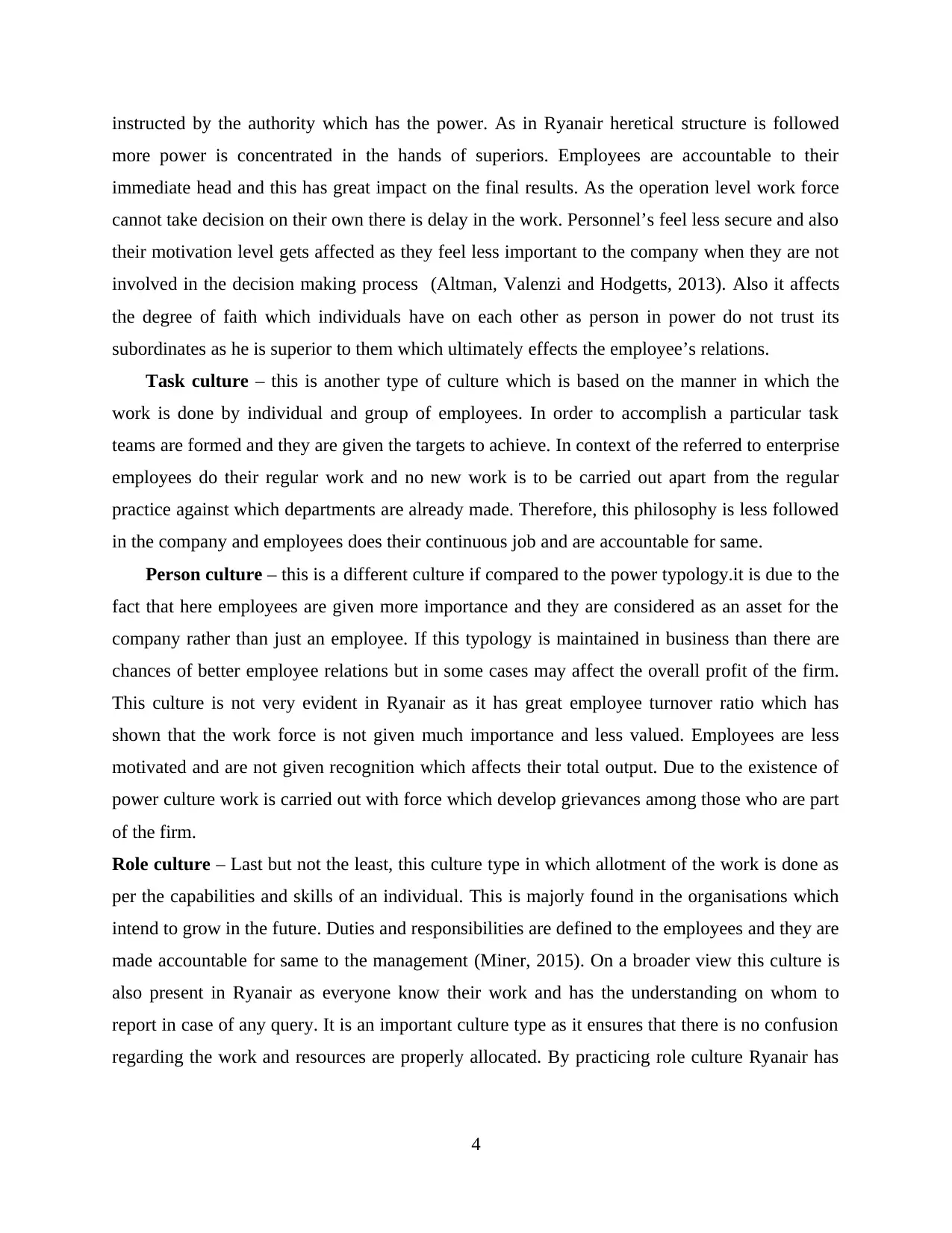
instructed by the authority which has the power. As in Ryanair heretical structure is followed
more power is concentrated in the hands of superiors. Employees are accountable to their
immediate head and this has great impact on the final results. As the operation level work force
cannot take decision on their own there is delay in the work. Personnel’s feel less secure and also
their motivation level gets affected as they feel less important to the company when they are not
involved in the decision making process (Altman, Valenzi and Hodgetts, 2013). Also it affects
the degree of faith which individuals have on each other as person in power do not trust its
subordinates as he is superior to them which ultimately effects the employee’s relations.
Task culture – this is another type of culture which is based on the manner in which the
work is done by individual and group of employees. In order to accomplish a particular task
teams are formed and they are given the targets to achieve. In context of the referred to enterprise
employees do their regular work and no new work is to be carried out apart from the regular
practice against which departments are already made. Therefore, this philosophy is less followed
in the company and employees does their continuous job and are accountable for same.
Person culture – this is a different culture if compared to the power typology.it is due to the
fact that here employees are given more importance and they are considered as an asset for the
company rather than just an employee. If this typology is maintained in business than there are
chances of better employee relations but in some cases may affect the overall profit of the firm.
This culture is not very evident in Ryanair as it has great employee turnover ratio which has
shown that the work force is not given much importance and less valued. Employees are less
motivated and are not given recognition which affects their total output. Due to the existence of
power culture work is carried out with force which develop grievances among those who are part
of the firm.
Role culture – Last but not the least, this culture type in which allotment of the work is done as
per the capabilities and skills of an individual. This is majorly found in the organisations which
intend to grow in the future. Duties and responsibilities are defined to the employees and they are
made accountable for same to the management (Miner, 2015). On a broader view this culture is
also present in Ryanair as everyone know their work and has the understanding on whom to
report in case of any query. It is an important culture type as it ensures that there is no confusion
regarding the work and resources are properly allocated. By practicing role culture Ryanair has
4
more power is concentrated in the hands of superiors. Employees are accountable to their
immediate head and this has great impact on the final results. As the operation level work force
cannot take decision on their own there is delay in the work. Personnel’s feel less secure and also
their motivation level gets affected as they feel less important to the company when they are not
involved in the decision making process (Altman, Valenzi and Hodgetts, 2013). Also it affects
the degree of faith which individuals have on each other as person in power do not trust its
subordinates as he is superior to them which ultimately effects the employee’s relations.
Task culture – this is another type of culture which is based on the manner in which the
work is done by individual and group of employees. In order to accomplish a particular task
teams are formed and they are given the targets to achieve. In context of the referred to enterprise
employees do their regular work and no new work is to be carried out apart from the regular
practice against which departments are already made. Therefore, this philosophy is less followed
in the company and employees does their continuous job and are accountable for same.
Person culture – this is a different culture if compared to the power typology.it is due to the
fact that here employees are given more importance and they are considered as an asset for the
company rather than just an employee. If this typology is maintained in business than there are
chances of better employee relations but in some cases may affect the overall profit of the firm.
This culture is not very evident in Ryanair as it has great employee turnover ratio which has
shown that the work force is not given much importance and less valued. Employees are less
motivated and are not given recognition which affects their total output. Due to the existence of
power culture work is carried out with force which develop grievances among those who are part
of the firm.
Role culture – Last but not the least, this culture type in which allotment of the work is done as
per the capabilities and skills of an individual. This is majorly found in the organisations which
intend to grow in the future. Duties and responsibilities are defined to the employees and they are
made accountable for same to the management (Miner, 2015). On a broader view this culture is
also present in Ryanair as everyone know their work and has the understanding on whom to
report in case of any query. It is an important culture type as it ensures that there is no confusion
regarding the work and resources are properly allocated. By practicing role culture Ryanair has
4
Secure Best Marks with AI Grader
Need help grading? Try our AI Grader for instant feedback on your assignments.
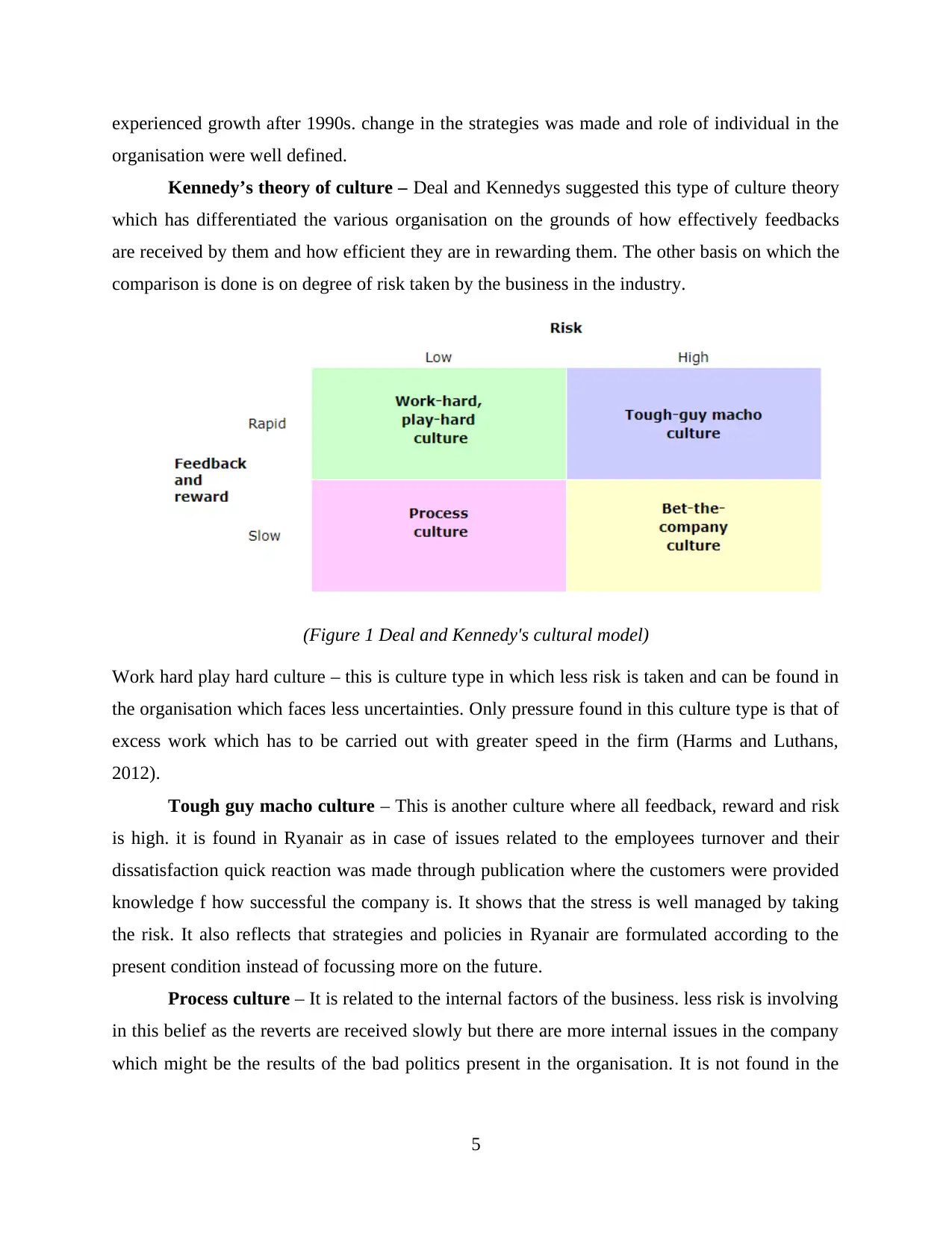
experienced growth after 1990s. change in the strategies was made and role of individual in the
organisation were well defined.
Kennedy’s theory of culture – Deal and Kennedys suggested this type of culture theory
which has differentiated the various organisation on the grounds of how effectively feedbacks
are received by them and how efficient they are in rewarding them. The other basis on which the
comparison is done is on degree of risk taken by the business in the industry.
(Figure 1 Deal and Kennedy's cultural model)
Work hard play hard culture – this is culture type in which less risk is taken and can be found in
the organisation which faces less uncertainties. Only pressure found in this culture type is that of
excess work which has to be carried out with greater speed in the firm (Harms and Luthans,
2012).
Tough guy macho culture – This is another culture where all feedback, reward and risk
is high. it is found in Ryanair as in case of issues related to the employees turnover and their
dissatisfaction quick reaction was made through publication where the customers were provided
knowledge f how successful the company is. It shows that the stress is well managed by taking
the risk. It also reflects that strategies and policies in Ryanair are formulated according to the
present condition instead of focussing more on the future.
Process culture – It is related to the internal factors of the business. less risk is involving
in this belief as the reverts are received slowly but there are more internal issues in the company
which might be the results of the bad politics present in the organisation. It is not found in the
5
organisation were well defined.
Kennedy’s theory of culture – Deal and Kennedys suggested this type of culture theory
which has differentiated the various organisation on the grounds of how effectively feedbacks
are received by them and how efficient they are in rewarding them. The other basis on which the
comparison is done is on degree of risk taken by the business in the industry.
(Figure 1 Deal and Kennedy's cultural model)
Work hard play hard culture – this is culture type in which less risk is taken and can be found in
the organisation which faces less uncertainties. Only pressure found in this culture type is that of
excess work which has to be carried out with greater speed in the firm (Harms and Luthans,
2012).
Tough guy macho culture – This is another culture where all feedback, reward and risk
is high. it is found in Ryanair as in case of issues related to the employees turnover and their
dissatisfaction quick reaction was made through publication where the customers were provided
knowledge f how successful the company is. It shows that the stress is well managed by taking
the risk. It also reflects that strategies and policies in Ryanair are formulated according to the
present condition instead of focussing more on the future.
Process culture – It is related to the internal factors of the business. less risk is involving
in this belief as the reverts are received slowly but there are more internal issues in the company
which might be the results of the bad politics present in the organisation. It is not found in the
5
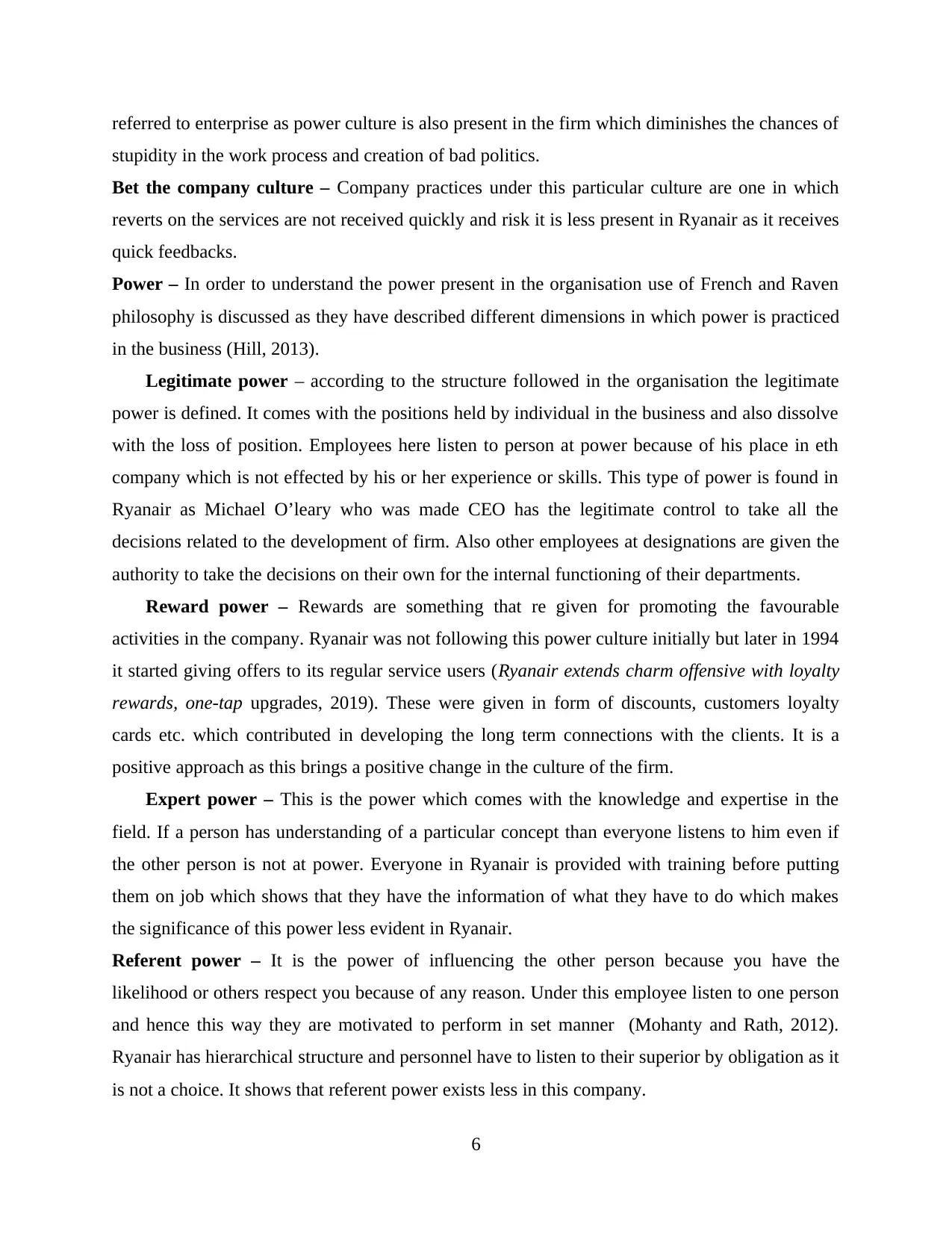
referred to enterprise as power culture is also present in the firm which diminishes the chances of
stupidity in the work process and creation of bad politics.
Bet the company culture – Company practices under this particular culture are one in which
reverts on the services are not received quickly and risk it is less present in Ryanair as it receives
quick feedbacks.
Power – In order to understand the power present in the organisation use of French and Raven
philosophy is discussed as they have described different dimensions in which power is practiced
in the business (Hill, 2013).
Legitimate power – according to the structure followed in the organisation the legitimate
power is defined. It comes with the positions held by individual in the business and also dissolve
with the loss of position. Employees here listen to person at power because of his place in eth
company which is not effected by his or her experience or skills. This type of power is found in
Ryanair as Michael O’leary who was made CEO has the legitimate control to take all the
decisions related to the development of firm. Also other employees at designations are given the
authority to take the decisions on their own for the internal functioning of their departments.
Reward power – Rewards are something that re given for promoting the favourable
activities in the company. Ryanair was not following this power culture initially but later in 1994
it started giving offers to its regular service users (Ryanair extends charm offensive with loyalty
rewards, one-tap upgrades, 2019). These were given in form of discounts, customers loyalty
cards etc. which contributed in developing the long term connections with the clients. It is a
positive approach as this brings a positive change in the culture of the firm.
Expert power – This is the power which comes with the knowledge and expertise in the
field. If a person has understanding of a particular concept than everyone listens to him even if
the other person is not at power. Everyone in Ryanair is provided with training before putting
them on job which shows that they have the information of what they have to do which makes
the significance of this power less evident in Ryanair.
Referent power – It is the power of influencing the other person because you have the
likelihood or others respect you because of any reason. Under this employee listen to one person
and hence this way they are motivated to perform in set manner (Mohanty and Rath, 2012).
Ryanair has hierarchical structure and personnel have to listen to their superior by obligation as it
is not a choice. It shows that referent power exists less in this company.
6
stupidity in the work process and creation of bad politics.
Bet the company culture – Company practices under this particular culture are one in which
reverts on the services are not received quickly and risk it is less present in Ryanair as it receives
quick feedbacks.
Power – In order to understand the power present in the organisation use of French and Raven
philosophy is discussed as they have described different dimensions in which power is practiced
in the business (Hill, 2013).
Legitimate power – according to the structure followed in the organisation the legitimate
power is defined. It comes with the positions held by individual in the business and also dissolve
with the loss of position. Employees here listen to person at power because of his place in eth
company which is not effected by his or her experience or skills. This type of power is found in
Ryanair as Michael O’leary who was made CEO has the legitimate control to take all the
decisions related to the development of firm. Also other employees at designations are given the
authority to take the decisions on their own for the internal functioning of their departments.
Reward power – Rewards are something that re given for promoting the favourable
activities in the company. Ryanair was not following this power culture initially but later in 1994
it started giving offers to its regular service users (Ryanair extends charm offensive with loyalty
rewards, one-tap upgrades, 2019). These were given in form of discounts, customers loyalty
cards etc. which contributed in developing the long term connections with the clients. It is a
positive approach as this brings a positive change in the culture of the firm.
Expert power – This is the power which comes with the knowledge and expertise in the
field. If a person has understanding of a particular concept than everyone listens to him even if
the other person is not at power. Everyone in Ryanair is provided with training before putting
them on job which shows that they have the information of what they have to do which makes
the significance of this power less evident in Ryanair.
Referent power – It is the power of influencing the other person because you have the
likelihood or others respect you because of any reason. Under this employee listen to one person
and hence this way they are motivated to perform in set manner (Mohanty and Rath, 2012).
Ryanair has hierarchical structure and personnel have to listen to their superior by obligation as it
is not a choice. It shows that referent power exists less in this company.
6
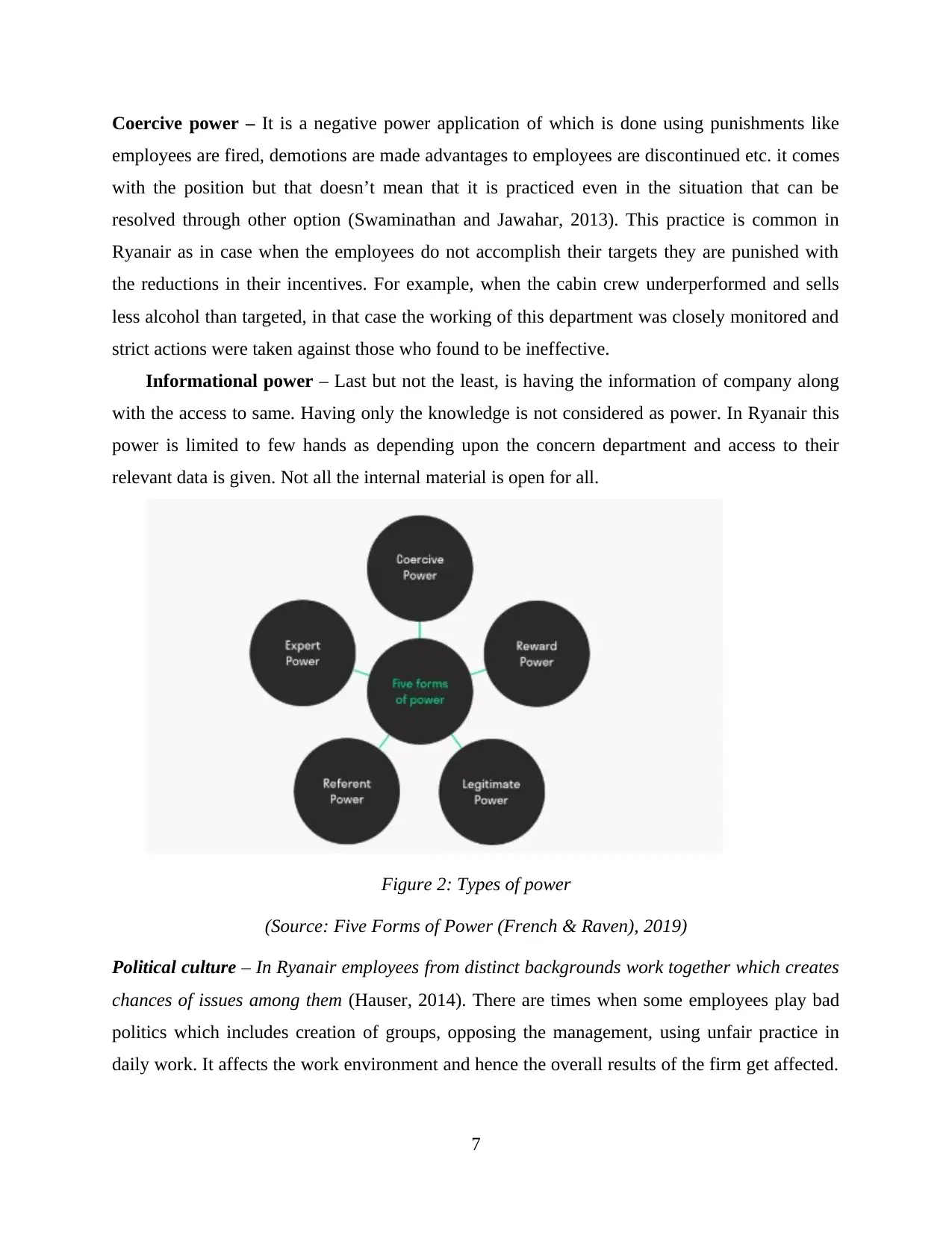
Coercive power – It is a negative power application of which is done using punishments like
employees are fired, demotions are made advantages to employees are discontinued etc. it comes
with the position but that doesn’t mean that it is practiced even in the situation that can be
resolved through other option (Swaminathan and Jawahar, 2013). This practice is common in
Ryanair as in case when the employees do not accomplish their targets they are punished with
the reductions in their incentives. For example, when the cabin crew underperformed and sells
less alcohol than targeted, in that case the working of this department was closely monitored and
strict actions were taken against those who found to be ineffective.
Informational power – Last but not the least, is having the information of company along
with the access to same. Having only the knowledge is not considered as power. In Ryanair this
power is limited to few hands as depending upon the concern department and access to their
relevant data is given. Not all the internal material is open for all.
Figure 2: Types of power
(Source: Five Forms of Power (French & Raven), 2019)
Political culture – In Ryanair employees from distinct backgrounds work together which creates
chances of issues among them (Hauser, 2014). There are times when some employees play bad
politics which includes creation of groups, opposing the management, using unfair practice in
daily work. It affects the work environment and hence the overall results of the firm get affected.
7
employees are fired, demotions are made advantages to employees are discontinued etc. it comes
with the position but that doesn’t mean that it is practiced even in the situation that can be
resolved through other option (Swaminathan and Jawahar, 2013). This practice is common in
Ryanair as in case when the employees do not accomplish their targets they are punished with
the reductions in their incentives. For example, when the cabin crew underperformed and sells
less alcohol than targeted, in that case the working of this department was closely monitored and
strict actions were taken against those who found to be ineffective.
Informational power – Last but not the least, is having the information of company along
with the access to same. Having only the knowledge is not considered as power. In Ryanair this
power is limited to few hands as depending upon the concern department and access to their
relevant data is given. Not all the internal material is open for all.
Figure 2: Types of power
(Source: Five Forms of Power (French & Raven), 2019)
Political culture – In Ryanair employees from distinct backgrounds work together which creates
chances of issues among them (Hauser, 2014). There are times when some employees play bad
politics which includes creation of groups, opposing the management, using unfair practice in
daily work. It affects the work environment and hence the overall results of the firm get affected.
7
Paraphrase This Document
Need a fresh take? Get an instant paraphrase of this document with our AI Paraphraser
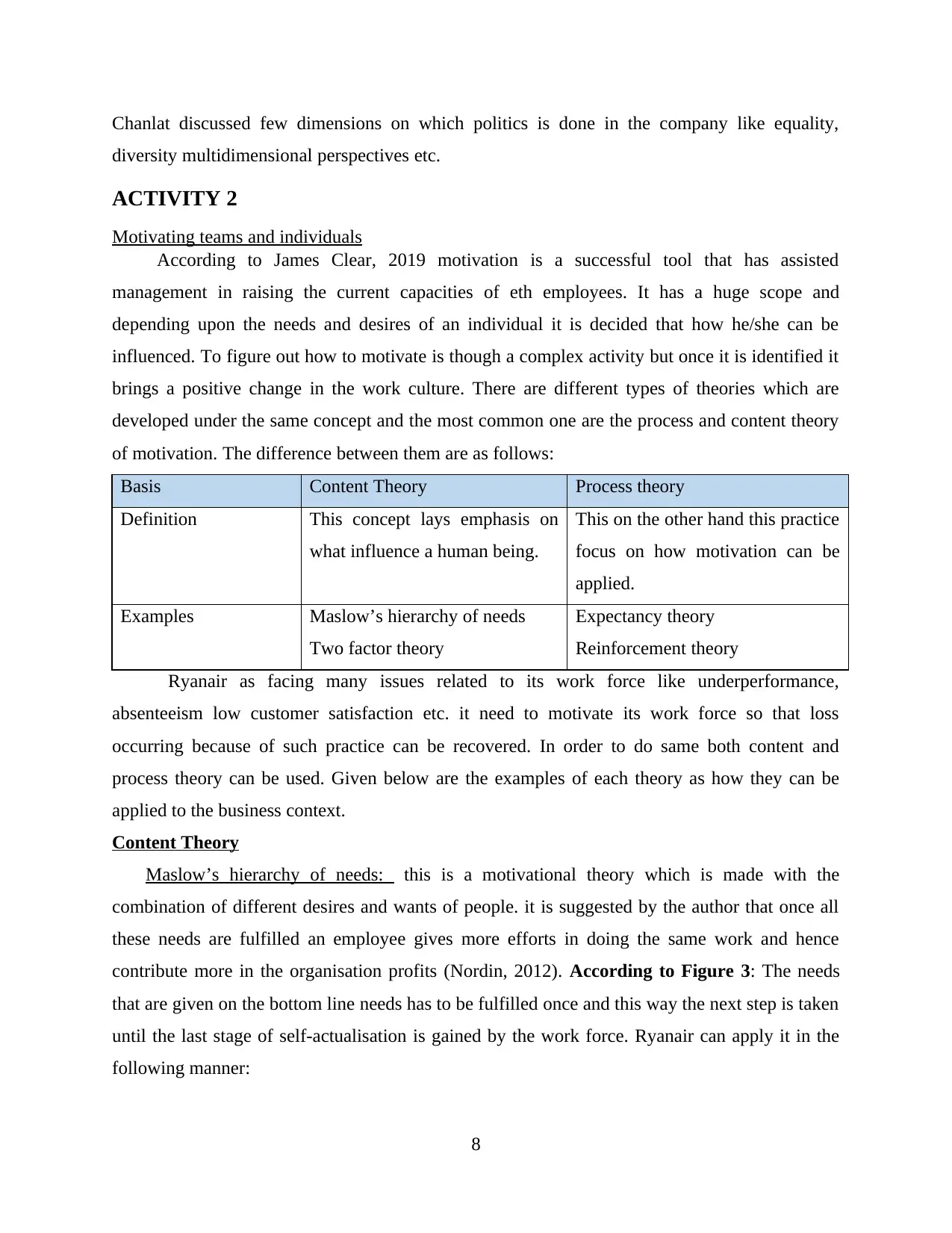
Chanlat discussed few dimensions on which politics is done in the company like equality,
diversity multidimensional perspectives etc.
ACTIVITY 2
Motivating teams and individuals
According to James Clear, 2019 motivation is a successful tool that has assisted
management in raising the current capacities of eth employees. It has a huge scope and
depending upon the needs and desires of an individual it is decided that how he/she can be
influenced. To figure out how to motivate is though a complex activity but once it is identified it
brings a positive change in the work culture. There are different types of theories which are
developed under the same concept and the most common one are the process and content theory
of motivation. The difference between them are as follows:
Basis Content Theory Process theory
Definition This concept lays emphasis on
what influence a human being.
This on the other hand this practice
focus on how motivation can be
applied.
Examples Maslow’s hierarchy of needs
Two factor theory
Expectancy theory
Reinforcement theory
Ryanair as facing many issues related to its work force like underperformance,
absenteeism low customer satisfaction etc. it need to motivate its work force so that loss
occurring because of such practice can be recovered. In order to do same both content and
process theory can be used. Given below are the examples of each theory as how they can be
applied to the business context.
Content Theory
Maslow’s hierarchy of needs: this is a motivational theory which is made with the
combination of different desires and wants of people. it is suggested by the author that once all
these needs are fulfilled an employee gives more efforts in doing the same work and hence
contribute more in the organisation profits (Nordin, 2012). According to Figure 3: The needs
that are given on the bottom line needs has to be fulfilled once and this way the next step is taken
until the last stage of self-actualisation is gained by the work force. Ryanair can apply it in the
following manner:
8
diversity multidimensional perspectives etc.
ACTIVITY 2
Motivating teams and individuals
According to James Clear, 2019 motivation is a successful tool that has assisted
management in raising the current capacities of eth employees. It has a huge scope and
depending upon the needs and desires of an individual it is decided that how he/she can be
influenced. To figure out how to motivate is though a complex activity but once it is identified it
brings a positive change in the work culture. There are different types of theories which are
developed under the same concept and the most common one are the process and content theory
of motivation. The difference between them are as follows:
Basis Content Theory Process theory
Definition This concept lays emphasis on
what influence a human being.
This on the other hand this practice
focus on how motivation can be
applied.
Examples Maslow’s hierarchy of needs
Two factor theory
Expectancy theory
Reinforcement theory
Ryanair as facing many issues related to its work force like underperformance,
absenteeism low customer satisfaction etc. it need to motivate its work force so that loss
occurring because of such practice can be recovered. In order to do same both content and
process theory can be used. Given below are the examples of each theory as how they can be
applied to the business context.
Content Theory
Maslow’s hierarchy of needs: this is a motivational theory which is made with the
combination of different desires and wants of people. it is suggested by the author that once all
these needs are fulfilled an employee gives more efforts in doing the same work and hence
contribute more in the organisation profits (Nordin, 2012). According to Figure 3: The needs
that are given on the bottom line needs has to be fulfilled once and this way the next step is taken
until the last stage of self-actualisation is gained by the work force. Ryanair can apply it in the
following manner:
8
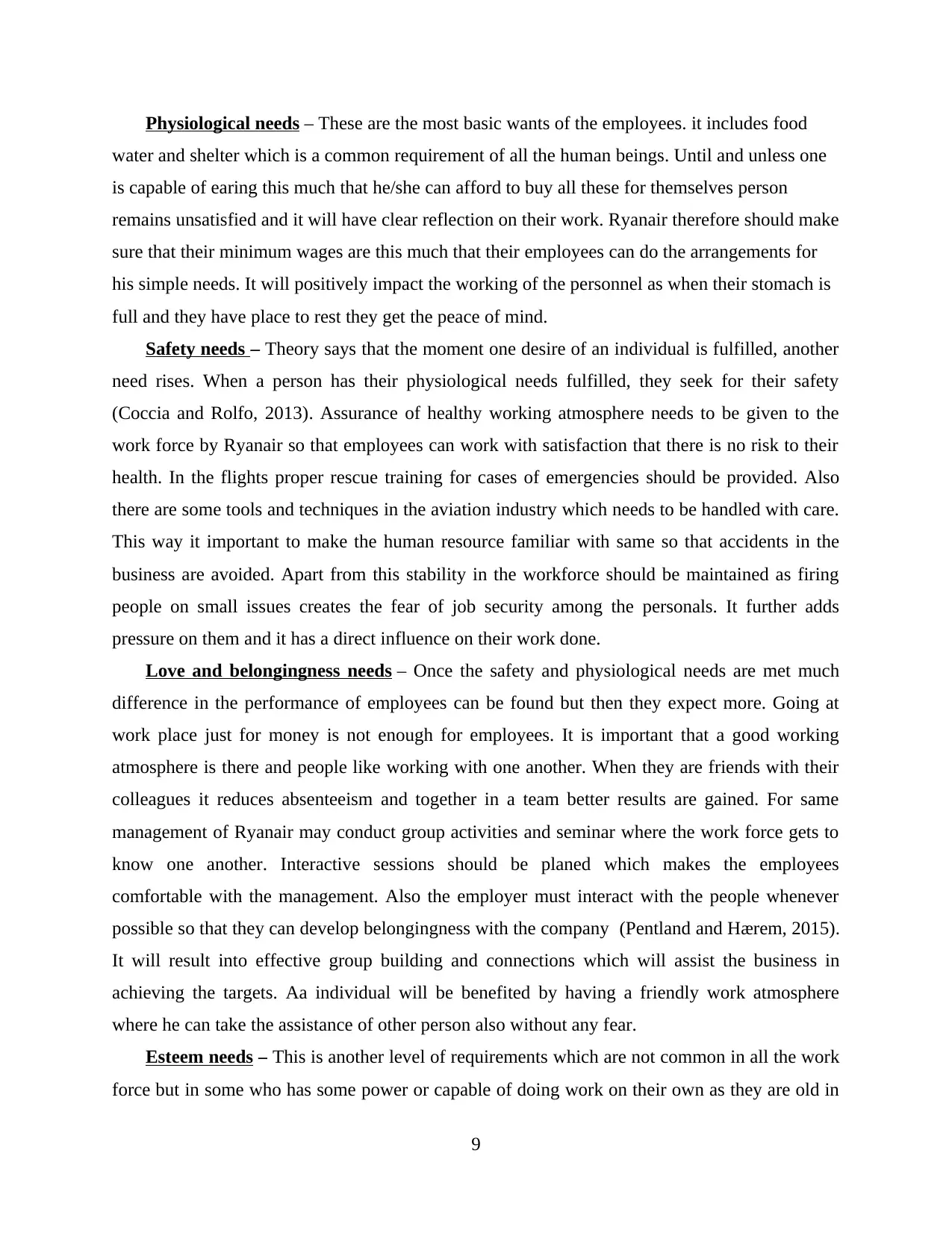
Physiological needs – These are the most basic wants of the employees. it includes food
water and shelter which is a common requirement of all the human beings. Until and unless one
is capable of earing this much that he/she can afford to buy all these for themselves person
remains unsatisfied and it will have clear reflection on their work. Ryanair therefore should make
sure that their minimum wages are this much that their employees can do the arrangements for
his simple needs. It will positively impact the working of the personnel as when their stomach is
full and they have place to rest they get the peace of mind.
Safety needs – Theory says that the moment one desire of an individual is fulfilled, another
need rises. When a person has their physiological needs fulfilled, they seek for their safety
(Coccia and Rolfo, 2013). Assurance of healthy working atmosphere needs to be given to the
work force by Ryanair so that employees can work with satisfaction that there is no risk to their
health. In the flights proper rescue training for cases of emergencies should be provided. Also
there are some tools and techniques in the aviation industry which needs to be handled with care.
This way it important to make the human resource familiar with same so that accidents in the
business are avoided. Apart from this stability in the workforce should be maintained as firing
people on small issues creates the fear of job security among the personals. It further adds
pressure on them and it has a direct influence on their work done.
Love and belongingness needs – Once the safety and physiological needs are met much
difference in the performance of employees can be found but then they expect more. Going at
work place just for money is not enough for employees. It is important that a good working
atmosphere is there and people like working with one another. When they are friends with their
colleagues it reduces absenteeism and together in a team better results are gained. For same
management of Ryanair may conduct group activities and seminar where the work force gets to
know one another. Interactive sessions should be planed which makes the employees
comfortable with the management. Also the employer must interact with the people whenever
possible so that they can develop belongingness with the company (Pentland and Hærem, 2015).
It will result into effective group building and connections which will assist the business in
achieving the targets. Aa individual will be benefited by having a friendly work atmosphere
where he can take the assistance of other person also without any fear.
Esteem needs – This is another level of requirements which are not common in all the work
force but in some who has some power or capable of doing work on their own as they are old in
9
water and shelter which is a common requirement of all the human beings. Until and unless one
is capable of earing this much that he/she can afford to buy all these for themselves person
remains unsatisfied and it will have clear reflection on their work. Ryanair therefore should make
sure that their minimum wages are this much that their employees can do the arrangements for
his simple needs. It will positively impact the working of the personnel as when their stomach is
full and they have place to rest they get the peace of mind.
Safety needs – Theory says that the moment one desire of an individual is fulfilled, another
need rises. When a person has their physiological needs fulfilled, they seek for their safety
(Coccia and Rolfo, 2013). Assurance of healthy working atmosphere needs to be given to the
work force by Ryanair so that employees can work with satisfaction that there is no risk to their
health. In the flights proper rescue training for cases of emergencies should be provided. Also
there are some tools and techniques in the aviation industry which needs to be handled with care.
This way it important to make the human resource familiar with same so that accidents in the
business are avoided. Apart from this stability in the workforce should be maintained as firing
people on small issues creates the fear of job security among the personals. It further adds
pressure on them and it has a direct influence on their work done.
Love and belongingness needs – Once the safety and physiological needs are met much
difference in the performance of employees can be found but then they expect more. Going at
work place just for money is not enough for employees. It is important that a good working
atmosphere is there and people like working with one another. When they are friends with their
colleagues it reduces absenteeism and together in a team better results are gained. For same
management of Ryanair may conduct group activities and seminar where the work force gets to
know one another. Interactive sessions should be planed which makes the employees
comfortable with the management. Also the employer must interact with the people whenever
possible so that they can develop belongingness with the company (Pentland and Hærem, 2015).
It will result into effective group building and connections which will assist the business in
achieving the targets. Aa individual will be benefited by having a friendly work atmosphere
where he can take the assistance of other person also without any fear.
Esteem needs – This is another level of requirements which are not common in all the work
force but in some who has some power or capable of doing work on their own as they are old in
9
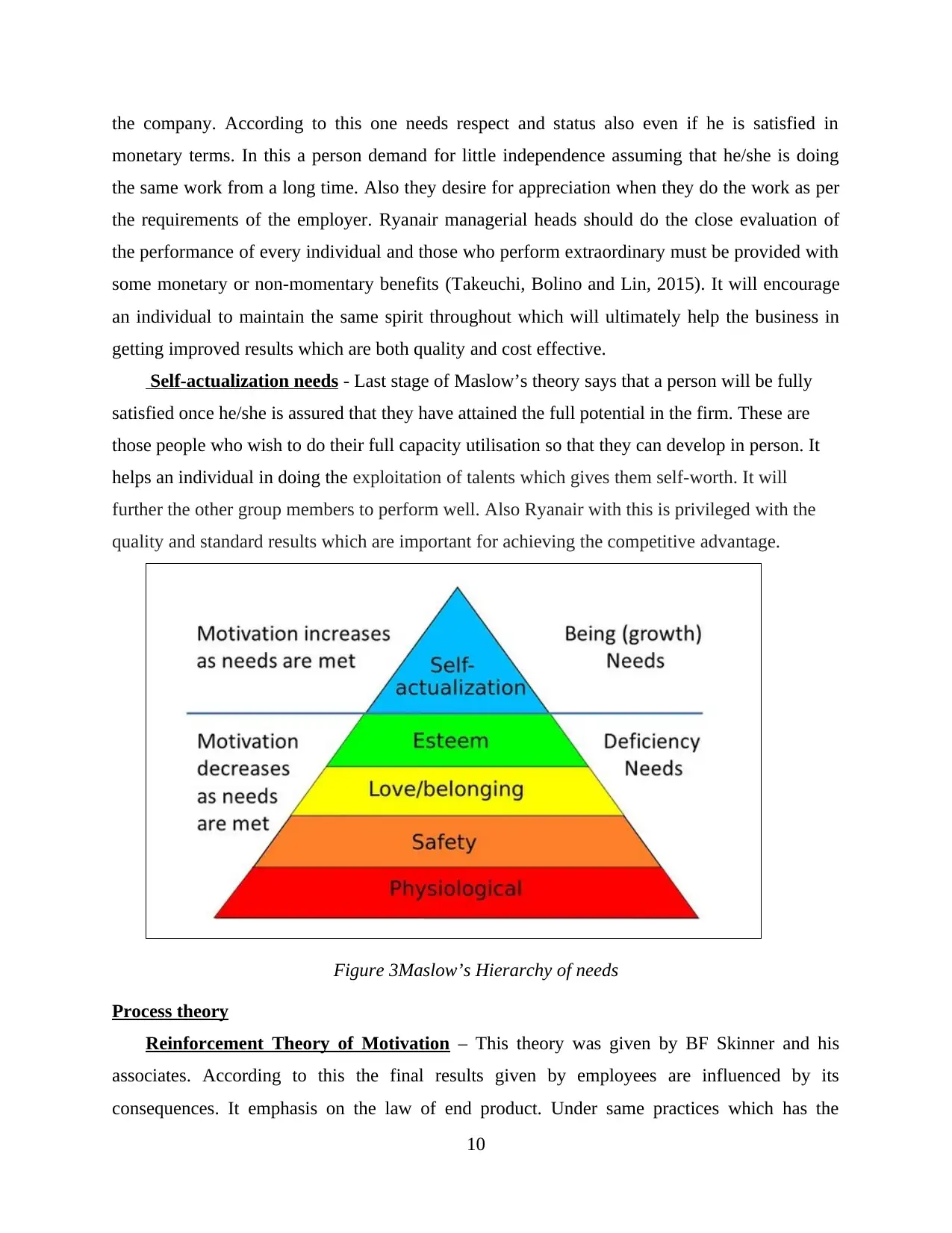
the company. According to this one needs respect and status also even if he is satisfied in
monetary terms. In this a person demand for little independence assuming that he/she is doing
the same work from a long time. Also they desire for appreciation when they do the work as per
the requirements of the employer. Ryanair managerial heads should do the close evaluation of
the performance of every individual and those who perform extraordinary must be provided with
some monetary or non-momentary benefits (Takeuchi, Bolino and Lin, 2015). It will encourage
an individual to maintain the same spirit throughout which will ultimately help the business in
getting improved results which are both quality and cost effective.
Self-actualization needs - Last stage of Maslow’s theory says that a person will be fully
satisfied once he/she is assured that they have attained the full potential in the firm. These are
those people who wish to do their full capacity utilisation so that they can develop in person. It
helps an individual in doing the exploitation of talents which gives them self-worth. It will
further the other group members to perform well. Also Ryanair with this is privileged with the
quality and standard results which are important for achieving the competitive advantage.
Figure 3Maslow’s Hierarchy of needs
Process theory
Reinforcement Theory of Motivation – This theory was given by BF Skinner and his
associates. According to this the final results given by employees are influenced by its
consequences. It emphasis on the law of end product. Under same practices which has the
10
monetary terms. In this a person demand for little independence assuming that he/she is doing
the same work from a long time. Also they desire for appreciation when they do the work as per
the requirements of the employer. Ryanair managerial heads should do the close evaluation of
the performance of every individual and those who perform extraordinary must be provided with
some monetary or non-momentary benefits (Takeuchi, Bolino and Lin, 2015). It will encourage
an individual to maintain the same spirit throughout which will ultimately help the business in
getting improved results which are both quality and cost effective.
Self-actualization needs - Last stage of Maslow’s theory says that a person will be fully
satisfied once he/she is assured that they have attained the full potential in the firm. These are
those people who wish to do their full capacity utilisation so that they can develop in person. It
helps an individual in doing the exploitation of talents which gives them self-worth. It will
further the other group members to perform well. Also Ryanair with this is privileged with the
quality and standard results which are important for achieving the competitive advantage.
Figure 3Maslow’s Hierarchy of needs
Process theory
Reinforcement Theory of Motivation – This theory was given by BF Skinner and his
associates. According to this the final results given by employees are influenced by its
consequences. It emphasis on the law of end product. Under same practices which has the
10
Secure Best Marks with AI Grader
Need help grading? Try our AI Grader for instant feedback on your assignments.
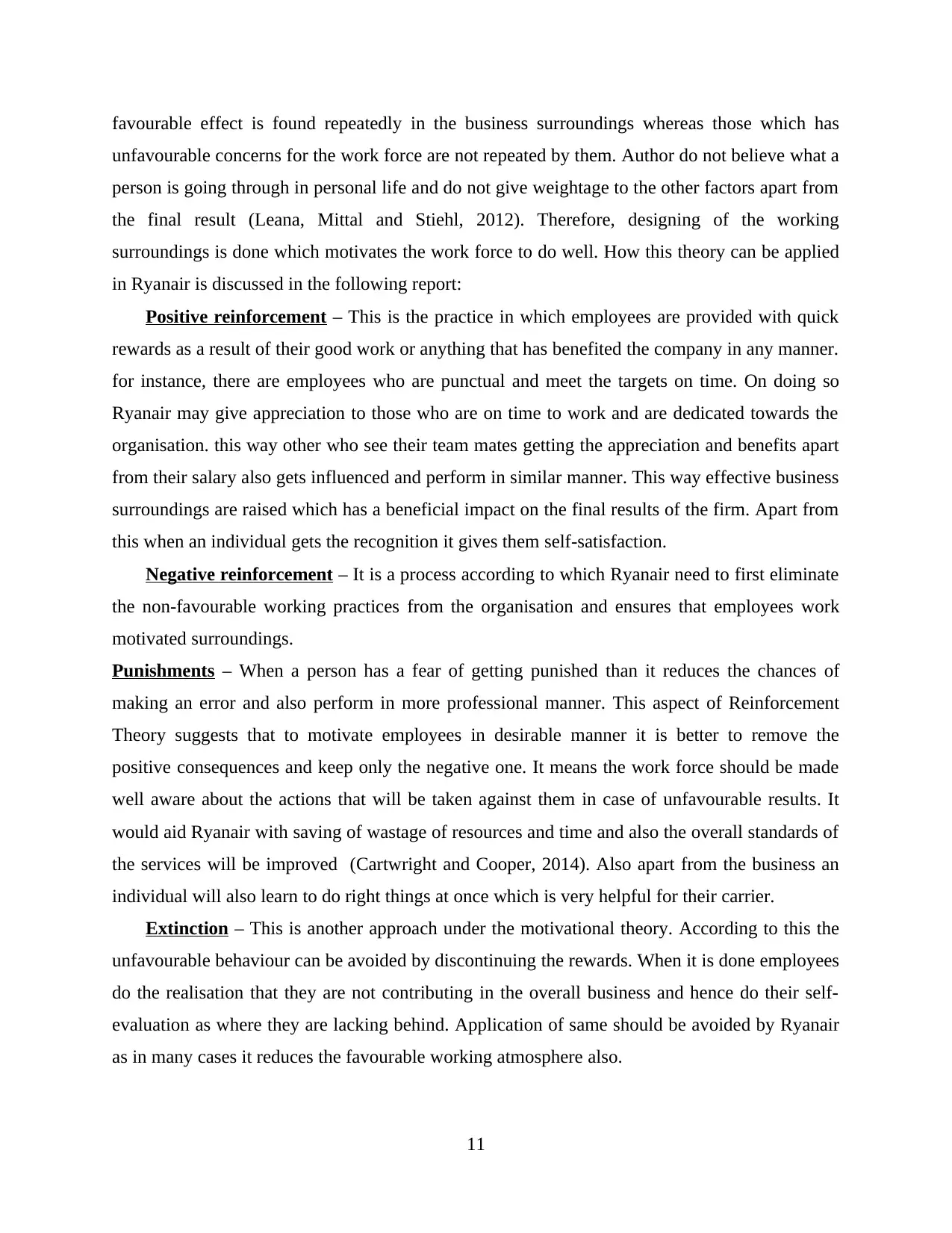
favourable effect is found repeatedly in the business surroundings whereas those which has
unfavourable concerns for the work force are not repeated by them. Author do not believe what a
person is going through in personal life and do not give weightage to the other factors apart from
the final result (Leana, Mittal and Stiehl, 2012). Therefore, designing of the working
surroundings is done which motivates the work force to do well. How this theory can be applied
in Ryanair is discussed in the following report:
Positive reinforcement – This is the practice in which employees are provided with quick
rewards as a result of their good work or anything that has benefited the company in any manner.
for instance, there are employees who are punctual and meet the targets on time. On doing so
Ryanair may give appreciation to those who are on time to work and are dedicated towards the
organisation. this way other who see their team mates getting the appreciation and benefits apart
from their salary also gets influenced and perform in similar manner. This way effective business
surroundings are raised which has a beneficial impact on the final results of the firm. Apart from
this when an individual gets the recognition it gives them self-satisfaction.
Negative reinforcement – It is a process according to which Ryanair need to first eliminate
the non-favourable working practices from the organisation and ensures that employees work
motivated surroundings.
Punishments – When a person has a fear of getting punished than it reduces the chances of
making an error and also perform in more professional manner. This aspect of Reinforcement
Theory suggests that to motivate employees in desirable manner it is better to remove the
positive consequences and keep only the negative one. It means the work force should be made
well aware about the actions that will be taken against them in case of unfavourable results. It
would aid Ryanair with saving of wastage of resources and time and also the overall standards of
the services will be improved (Cartwright and Cooper, 2014). Also apart from the business an
individual will also learn to do right things at once which is very helpful for their carrier.
Extinction – This is another approach under the motivational theory. According to this the
unfavourable behaviour can be avoided by discontinuing the rewards. When it is done employees
do the realisation that they are not contributing in the overall business and hence do their self-
evaluation as where they are lacking behind. Application of same should be avoided by Ryanair
as in many cases it reduces the favourable working atmosphere also.
11
unfavourable concerns for the work force are not repeated by them. Author do not believe what a
person is going through in personal life and do not give weightage to the other factors apart from
the final result (Leana, Mittal and Stiehl, 2012). Therefore, designing of the working
surroundings is done which motivates the work force to do well. How this theory can be applied
in Ryanair is discussed in the following report:
Positive reinforcement – This is the practice in which employees are provided with quick
rewards as a result of their good work or anything that has benefited the company in any manner.
for instance, there are employees who are punctual and meet the targets on time. On doing so
Ryanair may give appreciation to those who are on time to work and are dedicated towards the
organisation. this way other who see their team mates getting the appreciation and benefits apart
from their salary also gets influenced and perform in similar manner. This way effective business
surroundings are raised which has a beneficial impact on the final results of the firm. Apart from
this when an individual gets the recognition it gives them self-satisfaction.
Negative reinforcement – It is a process according to which Ryanair need to first eliminate
the non-favourable working practices from the organisation and ensures that employees work
motivated surroundings.
Punishments – When a person has a fear of getting punished than it reduces the chances of
making an error and also perform in more professional manner. This aspect of Reinforcement
Theory suggests that to motivate employees in desirable manner it is better to remove the
positive consequences and keep only the negative one. It means the work force should be made
well aware about the actions that will be taken against them in case of unfavourable results. It
would aid Ryanair with saving of wastage of resources and time and also the overall standards of
the services will be improved (Cartwright and Cooper, 2014). Also apart from the business an
individual will also learn to do right things at once which is very helpful for their carrier.
Extinction – This is another approach under the motivational theory. According to this the
unfavourable behaviour can be avoided by discontinuing the rewards. When it is done employees
do the realisation that they are not contributing in the overall business and hence do their self-
evaluation as where they are lacking behind. Application of same should be avoided by Ryanair
as in many cases it reduces the favourable working atmosphere also.
11
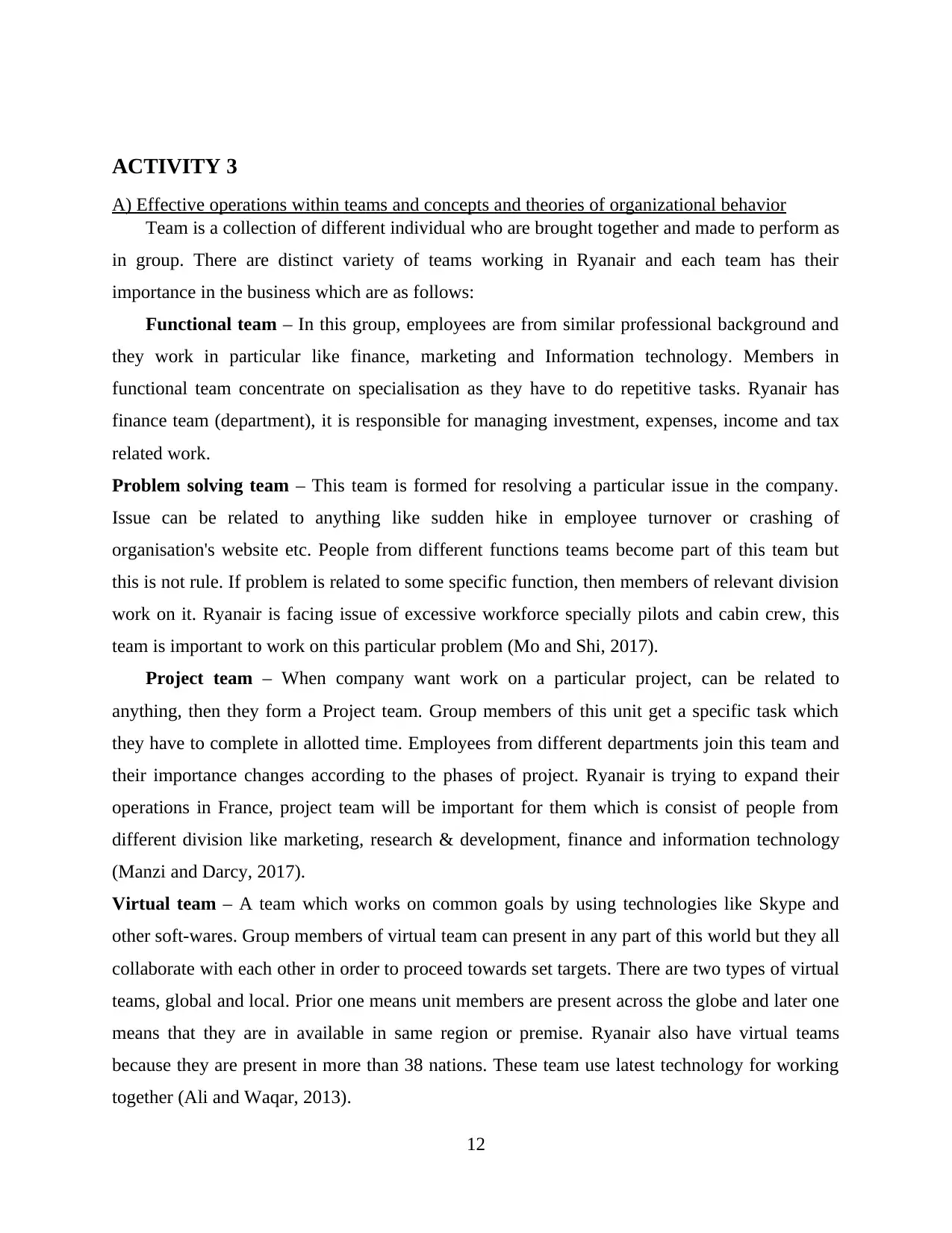
ACTIVITY 3
A) Effective operations within teams and concepts and theories of organizational behavior
Team is a collection of different individual who are brought together and made to perform as
in group. There are distinct variety of teams working in Ryanair and each team has their
importance in the business which are as follows:
Functional team – In this group, employees are from similar professional background and
they work in particular like finance, marketing and Information technology. Members in
functional team concentrate on specialisation as they have to do repetitive tasks. Ryanair has
finance team (department), it is responsible for managing investment, expenses, income and tax
related work.
Problem solving team – This team is formed for resolving a particular issue in the company.
Issue can be related to anything like sudden hike in employee turnover or crashing of
organisation's website etc. People from different functions teams become part of this team but
this is not rule. If problem is related to some specific function, then members of relevant division
work on it. Ryanair is facing issue of excessive workforce specially pilots and cabin crew, this
team is important to work on this particular problem (Mo and Shi, 2017).
Project team – When company want work on a particular project, can be related to
anything, then they form a Project team. Group members of this unit get a specific task which
they have to complete in allotted time. Employees from different departments join this team and
their importance changes according to the phases of project. Ryanair is trying to expand their
operations in France, project team will be important for them which is consist of people from
different division like marketing, research & development, finance and information technology
(Manzi and Darcy, 2017).
Virtual team – A team which works on common goals by using technologies like Skype and
other soft-wares. Group members of virtual team can present in any part of this world but they all
collaborate with each other in order to proceed towards set targets. There are two types of virtual
teams, global and local. Prior one means unit members are present across the globe and later one
means that they are in available in same region or premise. Ryanair also have virtual teams
because they are present in more than 38 nations. These team use latest technology for working
together (Ali and Waqar, 2013).
12
A) Effective operations within teams and concepts and theories of organizational behavior
Team is a collection of different individual who are brought together and made to perform as
in group. There are distinct variety of teams working in Ryanair and each team has their
importance in the business which are as follows:
Functional team – In this group, employees are from similar professional background and
they work in particular like finance, marketing and Information technology. Members in
functional team concentrate on specialisation as they have to do repetitive tasks. Ryanair has
finance team (department), it is responsible for managing investment, expenses, income and tax
related work.
Problem solving team – This team is formed for resolving a particular issue in the company.
Issue can be related to anything like sudden hike in employee turnover or crashing of
organisation's website etc. People from different functions teams become part of this team but
this is not rule. If problem is related to some specific function, then members of relevant division
work on it. Ryanair is facing issue of excessive workforce specially pilots and cabin crew, this
team is important to work on this particular problem (Mo and Shi, 2017).
Project team – When company want work on a particular project, can be related to
anything, then they form a Project team. Group members of this unit get a specific task which
they have to complete in allotted time. Employees from different departments join this team and
their importance changes according to the phases of project. Ryanair is trying to expand their
operations in France, project team will be important for them which is consist of people from
different division like marketing, research & development, finance and information technology
(Manzi and Darcy, 2017).
Virtual team – A team which works on common goals by using technologies like Skype and
other soft-wares. Group members of virtual team can present in any part of this world but they all
collaborate with each other in order to proceed towards set targets. There are two types of virtual
teams, global and local. Prior one means unit members are present across the globe and later one
means that they are in available in same region or premise. Ryanair also have virtual teams
because they are present in more than 38 nations. These team use latest technology for working
together (Ali and Waqar, 2013).
12
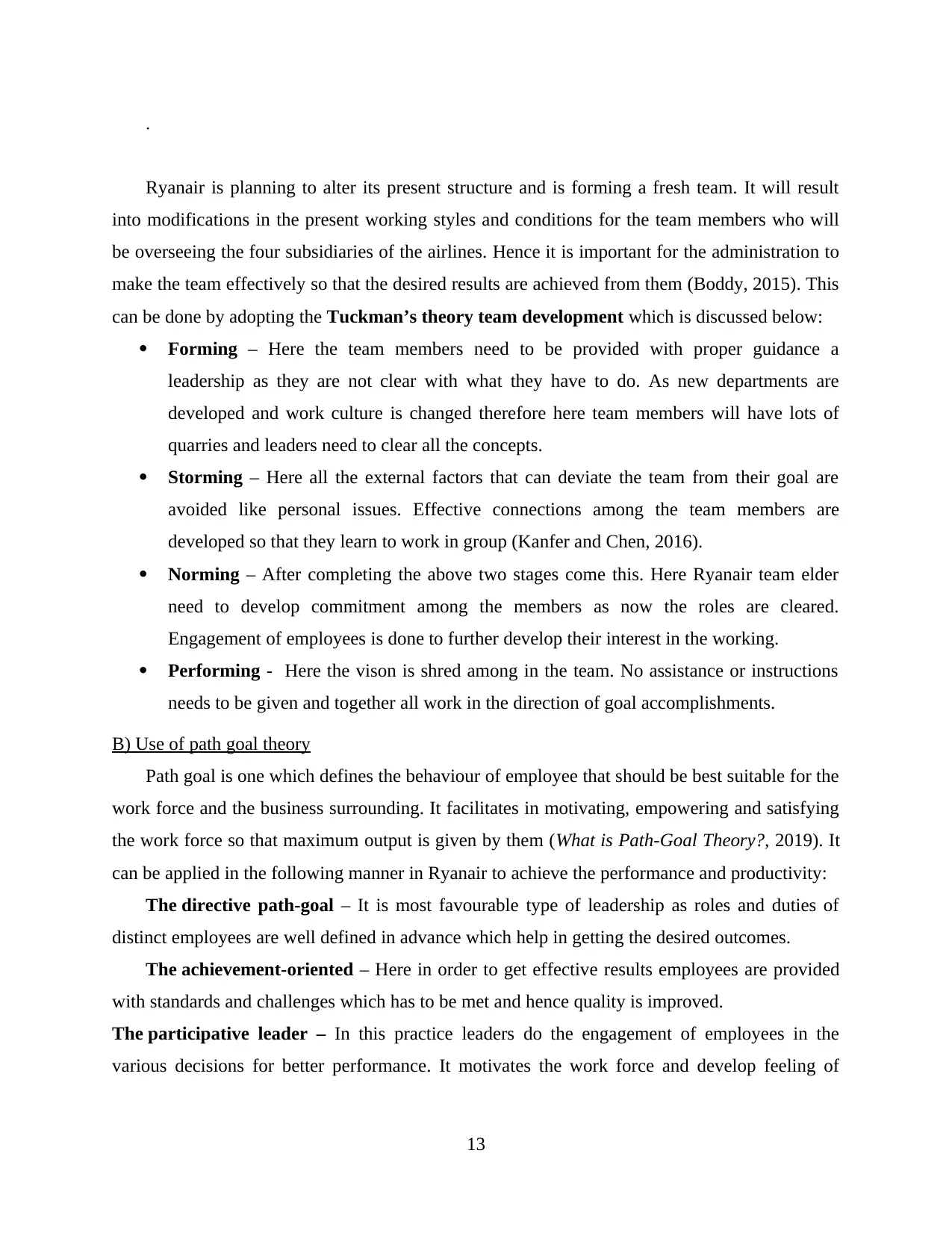
.
Ryanair is planning to alter its present structure and is forming a fresh team. It will result
into modifications in the present working styles and conditions for the team members who will
be overseeing the four subsidiaries of the airlines. Hence it is important for the administration to
make the team effectively so that the desired results are achieved from them (Boddy, 2015). This
can be done by adopting the Tuckman’s theory team development which is discussed below:
Forming – Here the team members need to be provided with proper guidance a
leadership as they are not clear with what they have to do. As new departments are
developed and work culture is changed therefore here team members will have lots of
quarries and leaders need to clear all the concepts.
Storming – Here all the external factors that can deviate the team from their goal are
avoided like personal issues. Effective connections among the team members are
developed so that they learn to work in group (Kanfer and Chen, 2016).
Norming – After completing the above two stages come this. Here Ryanair team elder
need to develop commitment among the members as now the roles are cleared.
Engagement of employees is done to further develop their interest in the working.
Performing - Here the vison is shred among in the team. No assistance or instructions
needs to be given and together all work in the direction of goal accomplishments.
B) Use of path goal theory
Path goal is one which defines the behaviour of employee that should be best suitable for the
work force and the business surrounding. It facilitates in motivating, empowering and satisfying
the work force so that maximum output is given by them (What is Path-Goal Theory?, 2019). It
can be applied in the following manner in Ryanair to achieve the performance and productivity:
The directive path-goal – It is most favourable type of leadership as roles and duties of
distinct employees are well defined in advance which help in getting the desired outcomes.
The achievement-oriented – Here in order to get effective results employees are provided
with standards and challenges which has to be met and hence quality is improved.
The participative leader – In this practice leaders do the engagement of employees in the
various decisions for better performance. It motivates the work force and develop feeling of
13
Ryanair is planning to alter its present structure and is forming a fresh team. It will result
into modifications in the present working styles and conditions for the team members who will
be overseeing the four subsidiaries of the airlines. Hence it is important for the administration to
make the team effectively so that the desired results are achieved from them (Boddy, 2015). This
can be done by adopting the Tuckman’s theory team development which is discussed below:
Forming – Here the team members need to be provided with proper guidance a
leadership as they are not clear with what they have to do. As new departments are
developed and work culture is changed therefore here team members will have lots of
quarries and leaders need to clear all the concepts.
Storming – Here all the external factors that can deviate the team from their goal are
avoided like personal issues. Effective connections among the team members are
developed so that they learn to work in group (Kanfer and Chen, 2016).
Norming – After completing the above two stages come this. Here Ryanair team elder
need to develop commitment among the members as now the roles are cleared.
Engagement of employees is done to further develop their interest in the working.
Performing - Here the vison is shred among in the team. No assistance or instructions
needs to be given and together all work in the direction of goal accomplishments.
B) Use of path goal theory
Path goal is one which defines the behaviour of employee that should be best suitable for the
work force and the business surrounding. It facilitates in motivating, empowering and satisfying
the work force so that maximum output is given by them (What is Path-Goal Theory?, 2019). It
can be applied in the following manner in Ryanair to achieve the performance and productivity:
The directive path-goal – It is most favourable type of leadership as roles and duties of
distinct employees are well defined in advance which help in getting the desired outcomes.
The achievement-oriented – Here in order to get effective results employees are provided
with standards and challenges which has to be met and hence quality is improved.
The participative leader – In this practice leaders do the engagement of employees in the
various decisions for better performance. It motivates the work force and develop feeling of
13
Paraphrase This Document
Need a fresh take? Get an instant paraphrase of this document with our AI Paraphraser
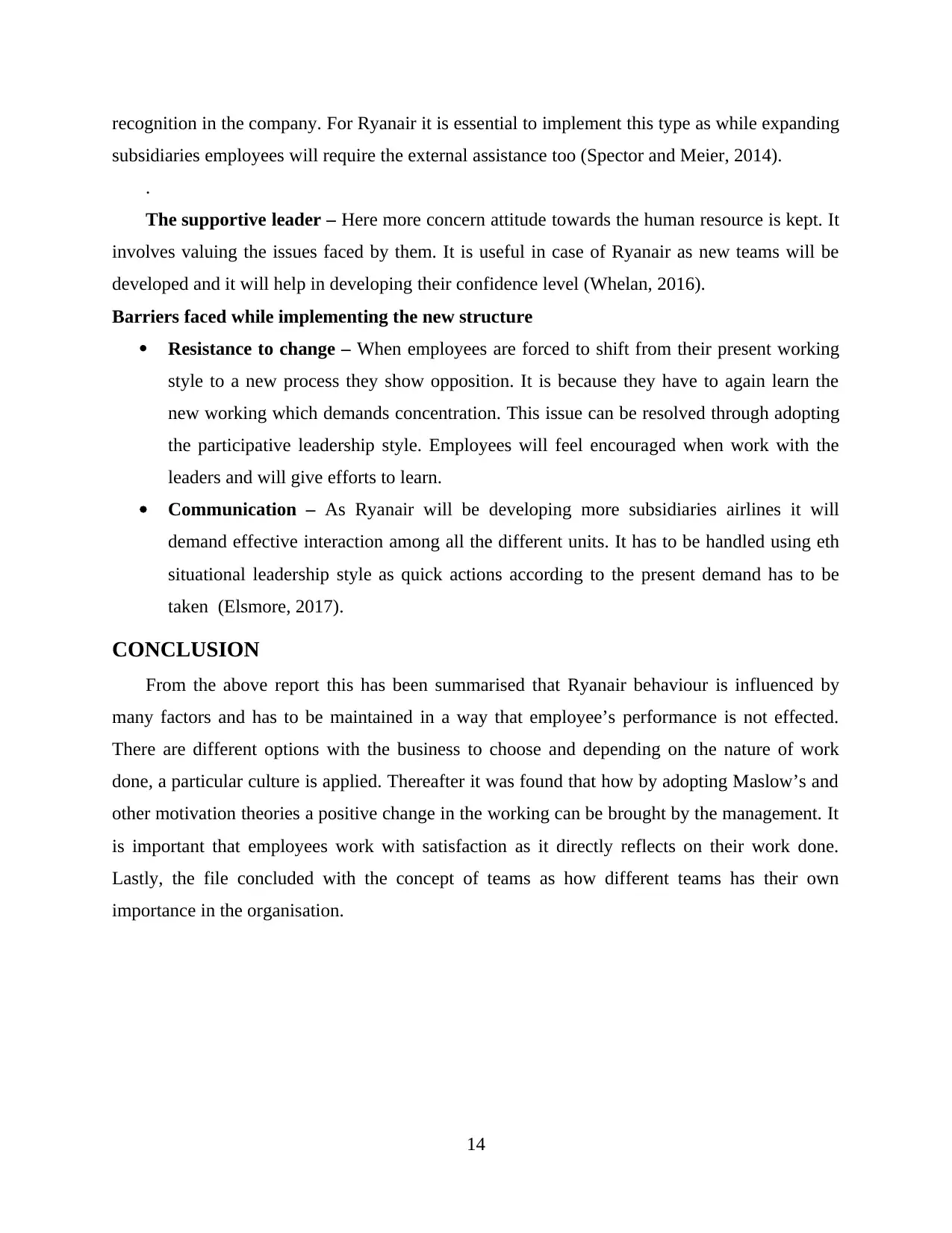
recognition in the company. For Ryanair it is essential to implement this type as while expanding
subsidiaries employees will require the external assistance too (Spector and Meier, 2014).
.
The supportive leader – Here more concern attitude towards the human resource is kept. It
involves valuing the issues faced by them. It is useful in case of Ryanair as new teams will be
developed and it will help in developing their confidence level (Whelan, 2016).
Barriers faced while implementing the new structure
Resistance to change – When employees are forced to shift from their present working
style to a new process they show opposition. It is because they have to again learn the
new working which demands concentration. This issue can be resolved through adopting
the participative leadership style. Employees will feel encouraged when work with the
leaders and will give efforts to learn.
Communication – As Ryanair will be developing more subsidiaries airlines it will
demand effective interaction among all the different units. It has to be handled using eth
situational leadership style as quick actions according to the present demand has to be
taken (Elsmore, 2017).
CONCLUSION
From the above report this has been summarised that Ryanair behaviour is influenced by
many factors and has to be maintained in a way that employee’s performance is not effected.
There are different options with the business to choose and depending on the nature of work
done, a particular culture is applied. Thereafter it was found that how by adopting Maslow’s and
other motivation theories a positive change in the working can be brought by the management. It
is important that employees work with satisfaction as it directly reflects on their work done.
Lastly, the file concluded with the concept of teams as how different teams has their own
importance in the organisation.
14
subsidiaries employees will require the external assistance too (Spector and Meier, 2014).
.
The supportive leader – Here more concern attitude towards the human resource is kept. It
involves valuing the issues faced by them. It is useful in case of Ryanair as new teams will be
developed and it will help in developing their confidence level (Whelan, 2016).
Barriers faced while implementing the new structure
Resistance to change – When employees are forced to shift from their present working
style to a new process they show opposition. It is because they have to again learn the
new working which demands concentration. This issue can be resolved through adopting
the participative leadership style. Employees will feel encouraged when work with the
leaders and will give efforts to learn.
Communication – As Ryanair will be developing more subsidiaries airlines it will
demand effective interaction among all the different units. It has to be handled using eth
situational leadership style as quick actions according to the present demand has to be
taken (Elsmore, 2017).
CONCLUSION
From the above report this has been summarised that Ryanair behaviour is influenced by
many factors and has to be maintained in a way that employee’s performance is not effected.
There are different options with the business to choose and depending on the nature of work
done, a particular culture is applied. Thereafter it was found that how by adopting Maslow’s and
other motivation theories a positive change in the working can be brought by the management. It
is important that employees work with satisfaction as it directly reflects on their work done.
Lastly, the file concluded with the concept of teams as how different teams has their own
importance in the organisation.
14
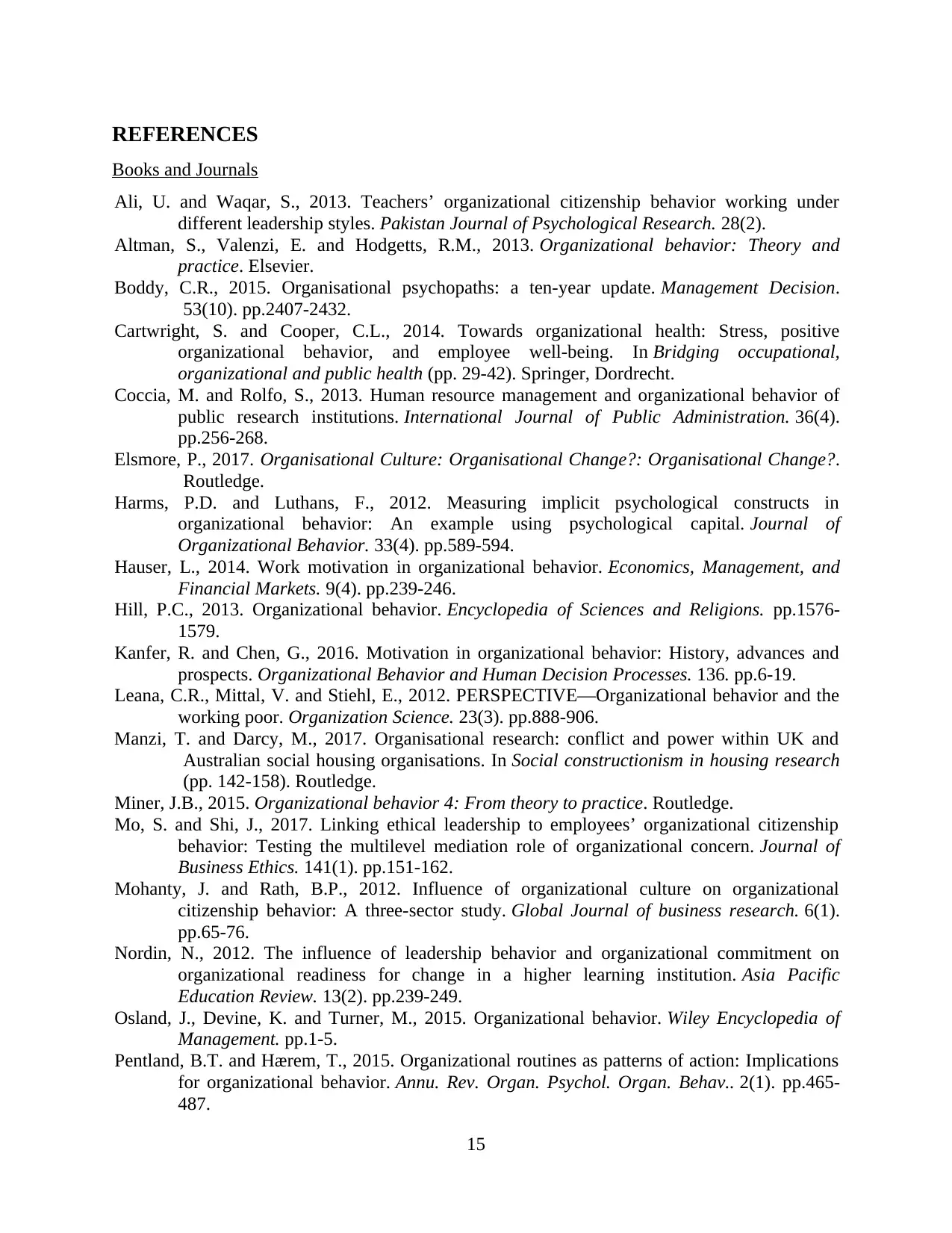
REFERENCES
Books and Journals
Ali, U. and Waqar, S., 2013. Teachers’ organizational citizenship behavior working under
different leadership styles. Pakistan Journal of Psychological Research. 28(2).
Altman, S., Valenzi, E. and Hodgetts, R.M., 2013. Organizational behavior: Theory and
practice. Elsevier.
Boddy, C.R., 2015. Organisational psychopaths: a ten-year update. Management Decision.
53(10). pp.2407-2432.
Cartwright, S. and Cooper, C.L., 2014. Towards organizational health: Stress, positive
organizational behavior, and employee well-being. In Bridging occupational,
organizational and public health (pp. 29-42). Springer, Dordrecht.
Coccia, M. and Rolfo, S., 2013. Human resource management and organizational behavior of
public research institutions. International Journal of Public Administration. 36(4).
pp.256-268.
Elsmore, P., 2017. Organisational Culture: Organisational Change?: Organisational Change?.
Routledge.
Harms, P.D. and Luthans, F., 2012. Measuring implicit psychological constructs in
organizational behavior: An example using psychological capital. Journal of
Organizational Behavior. 33(4). pp.589-594.
Hauser, L., 2014. Work motivation in organizational behavior. Economics, Management, and
Financial Markets. 9(4). pp.239-246.
Hill, P.C., 2013. Organizational behavior. Encyclopedia of Sciences and Religions. pp.1576-
1579.
Kanfer, R. and Chen, G., 2016. Motivation in organizational behavior: History, advances and
prospects. Organizational Behavior and Human Decision Processes. 136. pp.6-19.
Leana, C.R., Mittal, V. and Stiehl, E., 2012. PERSPECTIVE—Organizational behavior and the
working poor. Organization Science. 23(3). pp.888-906.
Manzi, T. and Darcy, M., 2017. Organisational research: conflict and power within UK and
Australian social housing organisations. In Social constructionism in housing research
(pp. 142-158). Routledge.
Miner, J.B., 2015. Organizational behavior 4: From theory to practice. Routledge.
Mo, S. and Shi, J., 2017. Linking ethical leadership to employees’ organizational citizenship
behavior: Testing the multilevel mediation role of organizational concern. Journal of
Business Ethics. 141(1). pp.151-162.
Mohanty, J. and Rath, B.P., 2012. Influence of organizational culture on organizational
citizenship behavior: A three-sector study. Global Journal of business research. 6(1).
pp.65-76.
Nordin, N., 2012. The influence of leadership behavior and organizational commitment on
organizational readiness for change in a higher learning institution. Asia Pacific
Education Review. 13(2). pp.239-249.
Osland, J., Devine, K. and Turner, M., 2015. Organizational behavior. Wiley Encyclopedia of
Management. pp.1-5.
Pentland, B.T. and Hærem, T., 2015. Organizational routines as patterns of action: Implications
for organizational behavior. Annu. Rev. Organ. Psychol. Organ. Behav.. 2(1). pp.465-
487.
15
Books and Journals
Ali, U. and Waqar, S., 2013. Teachers’ organizational citizenship behavior working under
different leadership styles. Pakistan Journal of Psychological Research. 28(2).
Altman, S., Valenzi, E. and Hodgetts, R.M., 2013. Organizational behavior: Theory and
practice. Elsevier.
Boddy, C.R., 2015. Organisational psychopaths: a ten-year update. Management Decision.
53(10). pp.2407-2432.
Cartwright, S. and Cooper, C.L., 2014. Towards organizational health: Stress, positive
organizational behavior, and employee well-being. In Bridging occupational,
organizational and public health (pp. 29-42). Springer, Dordrecht.
Coccia, M. and Rolfo, S., 2013. Human resource management and organizational behavior of
public research institutions. International Journal of Public Administration. 36(4).
pp.256-268.
Elsmore, P., 2017. Organisational Culture: Organisational Change?: Organisational Change?.
Routledge.
Harms, P.D. and Luthans, F., 2012. Measuring implicit psychological constructs in
organizational behavior: An example using psychological capital. Journal of
Organizational Behavior. 33(4). pp.589-594.
Hauser, L., 2014. Work motivation in organizational behavior. Economics, Management, and
Financial Markets. 9(4). pp.239-246.
Hill, P.C., 2013. Organizational behavior. Encyclopedia of Sciences and Religions. pp.1576-
1579.
Kanfer, R. and Chen, G., 2016. Motivation in organizational behavior: History, advances and
prospects. Organizational Behavior and Human Decision Processes. 136. pp.6-19.
Leana, C.R., Mittal, V. and Stiehl, E., 2012. PERSPECTIVE—Organizational behavior and the
working poor. Organization Science. 23(3). pp.888-906.
Manzi, T. and Darcy, M., 2017. Organisational research: conflict and power within UK and
Australian social housing organisations. In Social constructionism in housing research
(pp. 142-158). Routledge.
Miner, J.B., 2015. Organizational behavior 4: From theory to practice. Routledge.
Mo, S. and Shi, J., 2017. Linking ethical leadership to employees’ organizational citizenship
behavior: Testing the multilevel mediation role of organizational concern. Journal of
Business Ethics. 141(1). pp.151-162.
Mohanty, J. and Rath, B.P., 2012. Influence of organizational culture on organizational
citizenship behavior: A three-sector study. Global Journal of business research. 6(1).
pp.65-76.
Nordin, N., 2012. The influence of leadership behavior and organizational commitment on
organizational readiness for change in a higher learning institution. Asia Pacific
Education Review. 13(2). pp.239-249.
Osland, J., Devine, K. and Turner, M., 2015. Organizational behavior. Wiley Encyclopedia of
Management. pp.1-5.
Pentland, B.T. and Hærem, T., 2015. Organizational routines as patterns of action: Implications
for organizational behavior. Annu. Rev. Organ. Psychol. Organ. Behav.. 2(1). pp.465-
487.
15
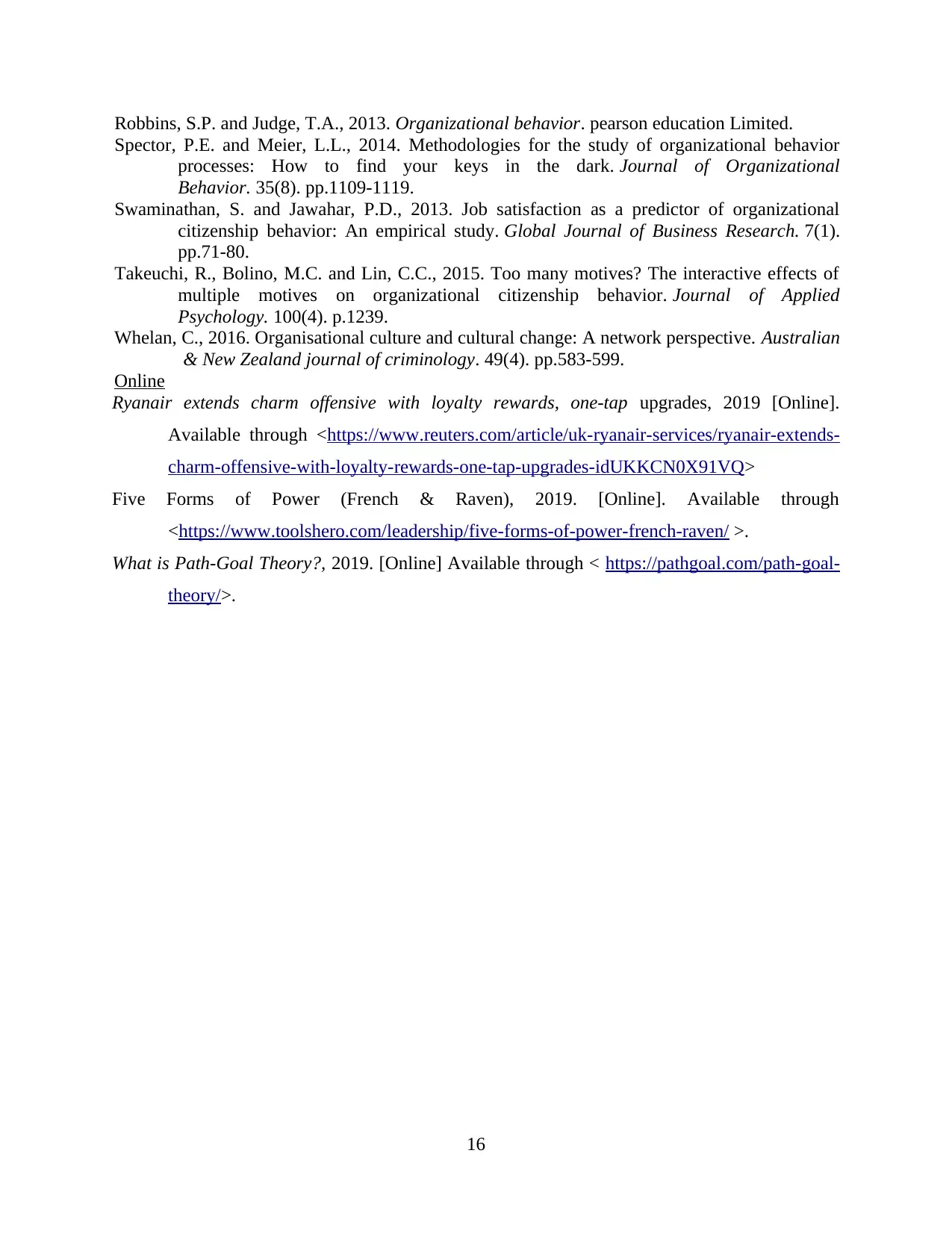
Robbins, S.P. and Judge, T.A., 2013. Organizational behavior. pearson education Limited.
Spector, P.E. and Meier, L.L., 2014. Methodologies for the study of organizational behavior
processes: How to find your keys in the dark. Journal of Organizational
Behavior. 35(8). pp.1109-1119.
Swaminathan, S. and Jawahar, P.D., 2013. Job satisfaction as a predictor of organizational
citizenship behavior: An empirical study. Global Journal of Business Research. 7(1).
pp.71-80.
Takeuchi, R., Bolino, M.C. and Lin, C.C., 2015. Too many motives? The interactive effects of
multiple motives on organizational citizenship behavior. Journal of Applied
Psychology. 100(4). p.1239.
Whelan, C., 2016. Organisational culture and cultural change: A network perspective. Australian
& New Zealand journal of criminology. 49(4). pp.583-599.
Online
Ryanair extends charm offensive with loyalty rewards, one-tap upgrades, 2019 [Online].
Available through <https://www.reuters.com/article/uk-ryanair-services/ryanair-extends-
charm-offensive-with-loyalty-rewards-one-tap-upgrades-idUKKCN0X91VQ>
Five Forms of Power (French & Raven), 2019. [Online]. Available through
<https://www.toolshero.com/leadership/five-forms-of-power-french-raven/ >.
What is Path-Goal Theory?, 2019. [Online] Available through < https://pathgoal.com/path-goal-
theory/>.
16
Spector, P.E. and Meier, L.L., 2014. Methodologies for the study of organizational behavior
processes: How to find your keys in the dark. Journal of Organizational
Behavior. 35(8). pp.1109-1119.
Swaminathan, S. and Jawahar, P.D., 2013. Job satisfaction as a predictor of organizational
citizenship behavior: An empirical study. Global Journal of Business Research. 7(1).
pp.71-80.
Takeuchi, R., Bolino, M.C. and Lin, C.C., 2015. Too many motives? The interactive effects of
multiple motives on organizational citizenship behavior. Journal of Applied
Psychology. 100(4). p.1239.
Whelan, C., 2016. Organisational culture and cultural change: A network perspective. Australian
& New Zealand journal of criminology. 49(4). pp.583-599.
Online
Ryanair extends charm offensive with loyalty rewards, one-tap upgrades, 2019 [Online].
Available through <https://www.reuters.com/article/uk-ryanair-services/ryanair-extends-
charm-offensive-with-loyalty-rewards-one-tap-upgrades-idUKKCN0X91VQ>
Five Forms of Power (French & Raven), 2019. [Online]. Available through
<https://www.toolshero.com/leadership/five-forms-of-power-french-raven/ >.
What is Path-Goal Theory?, 2019. [Online] Available through < https://pathgoal.com/path-goal-
theory/>.
16
Secure Best Marks with AI Grader
Need help grading? Try our AI Grader for instant feedback on your assignments.

17
1 out of 17
Related Documents
Your All-in-One AI-Powered Toolkit for Academic Success.
+13062052269
info@desklib.com
Available 24*7 on WhatsApp / Email
![[object Object]](/_next/static/media/star-bottom.7253800d.svg)
Unlock your academic potential
© 2024 | Zucol Services PVT LTD | All rights reserved.





